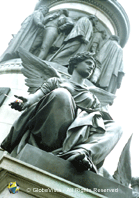O’Connell Monument

Public Art: O’Connell Monument
Also Known As: Daniel O’Connell Monument
Sculptor: © John Henry Foley (24th May 1818 – 27th August 1874)
Date Unveiled: 1882
Description: The 40ft monument was erected in honour of Daniel O’Connell the first Irish Nationalist leader. It features a 14ft bronze statue of Daniel O’Connell standing proudly atop. The middle section features a frieze representing the “Maid of Erin”. her right hand raised pointing to O’Connell, her liberator. In her left hand, she holds the 1829 Act of Catholic Emancipation. At the base are four-winged victories. Each Victory statue represents the virtues attributed to O’Connell; patriotism, courage, eloquence and fidelity. The frieze features over thirty figures symbolising the Church, the professions, the arts and the trades.
If you look closely two of the Victory statues have bullet holes from the 1916 Easter Rising.
Location: The Daniel O’Connell Monument is located at the end of O’Connell Street, Dublin, Ireland.
Commissioned By: The monument was originally commissioned by the O’Connell Monument Committee and then later by the Dublin Corporation.
Cost: £10,000
Who Was Daniel O’Connell?: Daniel O’Connor (6th of August, 1775-15th of May, 1847) was known as the “Liberator” and “Emancipator” who campaigned for Catholic Emancipation )the right for Catholics to sit in Westminster Parliament, denied for over 100 years) and Repeal of the union between Ireland and Great Britain.
Background to the Daniel O’Connell Monument: The O’Connell Monument took nearly 18 years for sculptor John Foley and his studio to complete. It was decided, following the death of O’Connell, that a monument would be a fitting gesture to commemorate his life. A committee was set up by Sir John Gray, with the understanding that it would reflect “his whole life and career, from the cradle to the grave so as to embrace the whole nation”.
On the 8th of August 1864, a 2 ton Dalkey granite foundation stone was laid on Sackville Street (later changed to O’Connell Street) by Lord Mayor Peter Paul McSwiney.
The Dublin Corporation later took over the responsibility of the monument and in the same year ran a competition to find the best design.
Meanwhile, Sir John Gray had been consulting with Irish-born sculptor John Henry Foley. Foley hadn’t entered the competition nor was he even living in Ireland during this time. Needless to say when the press got wind they were none too kind. The newspapers felt it unpatriotic to have a “foreigner” so to speak, create such an important monument.
The competition went ahead as planned whilst Gray continued discussing the project with Foley, despite the backlash. By January 1865 the committee had received over 60 designs which were all placed on display at City Hall.
Despite so many submissions, all were rejected. A new competition was held with the same outcome. Foley was again consulted under the proviso he had a “resident” sculptor assist him in designing subsidiary figures. Foley was not impressed and rejected the idea. He later agreed to a compromise. He would accept having an Irish architect submit designs. He, however, stipulated that he had the right to reject them. Not surprisingly he rejected the three designs submitted and continued on regardless.
In 1871 the committee received a project report by Foley. In it, he stated that due to his deteriorating health, massive workload and his procrastination, the project would be delayed until 1875.
Foley would once again fail to meet his deadline. He passed away in 1874. His apprentice, Thomas Brock, was left to finish the project. In June 1878, he was formally commissioned to complete it. At the time of Foley’s death, his Islington studio had a backlog of statues incomplete. They included the O’Connell Monument, Lovji Nusserwanjee Wadia statue (a shipping magnate from Gujarat), the Prince Albert Memorial, the General Hugh Gough statue (a military general who conquered Punjab) and the Stonewall Jackson statue (the leader of the Confederates during the US Civil War).
In 1882, 18 years after the idea was first conceived, the Daniel O’Connell statue was finally unveiled.
The monument bears the scars of the Irish conflicts between 1916-1922. If you look closely two of the angels have evidence of bullet marks.